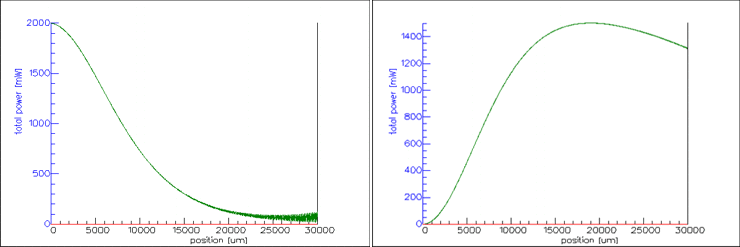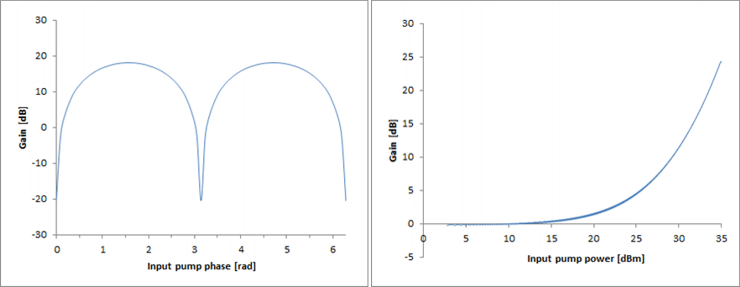PICWaveA photonic IC, laser diode and SOA simulator |
    |
PPLN: phase sensitive amplificationSimulation of Periodically-Poled Lithium Niobate devices with PICWave softwarePICWave has χ(2) (second-order susceptibility) non-linear model for the design and simulation of periodically-poled nonlinear sections (e.g. periodically-poled lithium niobate - PPLN) for second harmonic generation, phase sensitive amplification and wavelength conversion, amongst other things. The non-linear interaction parameters can be defined manually, or computed automatically from a defined waveguide cross-section with a χ² profile; the model automatically allows the cascading of sum and difference frequency interactions within a single section. Following [1], this example shows a PPLN section used as a phase sensitive amplifier. A large pump signal (2000mW) is injected at a central wavelength of 1546nm, along with a signal (to be amplified) and a matching idler (both 0.4mW) injected at ±4.6nm either side of the pump wavelength. As the pump propagates through the PPLN section, it generates a second harmonic (sum frequency interaction) due to the quasi-phase matching achieved using the periodic poling. The second harmonic then interacts (difference frequency interaction) with the signal and idler, leading to amplification of the signal. The amplification is dependent on both the relative phase between the pump and the signal/idler, and on the pump power.
After simulating the device, the amplification of the signal (and idler) and depletion of the pump can be seen by comparing the measured PPLN section input and output spectra - see plots below.
These phenomena can also be seen from the longitudinal profiles of the pump and second harmonic optical power. In addition, the subsequent decay of second harmonic as a result of its amplifying the signal can also be seen towards the end of the PPLN section.
The dependence of the amplification on pump phase and pump power are both easily obtained and are shown below. These results can be compared with those from the model in [1].
Reference[1] Kwang Jo Lee et al., "Phase sensitive amplification based on quadratic cascading in a periodically poled lithium niobate waveguide," Opt. Express 17, 20393-20400 (2009)
|







